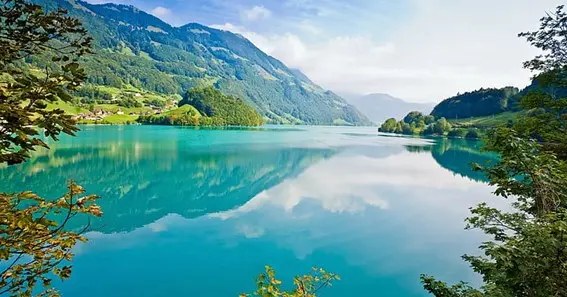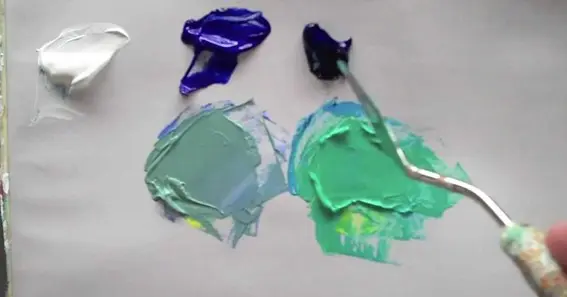What color is Cyan? Do you know the exact color of cyan? The color cyan can be defined simply as light blue, green color, bright blue, or green color. It is placed between the colors blue and green.
What color is Cyan?
Cyan is a light or bright blue shade with green tinting, like turquoise. It lies between blue and green in the color spectrum and signifies such emotional characteristics as calmness, innovativeness, and newness. Cyan is also commonly employed in design because it has a vivid and stimulating sensibility in digital media and printing contexts. It remains a favorite because of its flexibility in various activities, such as artwork business and logo designing, interior design, and fashion.
Cyan in Nature

Cyan in nature is frequently depicted in seas of tropical and freshwater reserves such as lakes, reproducing in the water the blue of the sky and the green of the surrounding flora. Some flowers possess cyan sepals or petals, including particular species of orchids and irises, as the bright coloration drew the pollinators.
Some animals, for example, butterflies and beetles, have cyan color in their wings used for camouflage or to signal that they are dangerous or inedible. In general, cyan brings freshness and fascination to the locales and makes the viewer healthy and happy.
Color Psychology of Cyan

Color psychology relates to how specific colors influence people’s behavior, moods, and even how they view things. They will understand how using different colors affects certain feelings and, in turn, how it can affect the mood of decision-making. Concisely, blues and yellows are colors that have psychological implications.
They can be employed in different modes, such as marketing and even therapy, depending on the purpose required and the kind of environment that will be produced. It is essential to know how specific colors influence people and their emotions and reactions and how to use that to convey various messages in everyday practice.
Chemical Properties of Cyan

Cyan color can be attributed to its pigments or dyes concerning the chemical nature of this shade. As for the pigments, cyan coloration usually consists of copper compounds, including copper (II) carbonate or copper (II) hydroxide. These compounds have typical features of absorptive coloration as they absorb red and yellow colors while reflecting blue and green.
Cyan dyes can be synthetic organic compounds where conjugated systems can spread light wavelengths to make the substance cyan. It is essential to comprehend these chemical traits for various uses, such as paint, ink, and fabric production. After understanding what color is Cyan let us see about mixing colours.
Color Mixing and Perception of Cyan

The process of combining two or more primary or secondary colors to produce related colors is called color mixing. At the same time, the additive color model shows cyan as a naturally bright shade of blue-green. It is often combined with other primary colors, including magenta and yellow, which contributes to the formation of secondary colors, thus adding to the intensity and variation of the perceived colors.
Environmental Significance of Cyan

The color cyan has an environmental context, as it always refers to nature and its attributes, such as water and the sky. In ecosystems, cyan colors represent healthy water systems and are actively engaged in photosynthesis, oxygen generation, and nutrient recycling, along with Cyanobacteria’s help in water.
Also, cyan-colored plants, in terms of the ability of plants with cyan coloration, including some algae and ferns, are valuable within the ecosystems because they serve as natural feed sources and shelters for various organisms. The fact that the element cyan is present in nature implies ecosystem dependency and the necessity to harvest biodiversity for a sustainable environment. After understanding what color is Cyan let us explore the digital imagining of the color cyan.
Digital Imaging of Cyan

Cyan is one of the primary colors used in the CMYK color model, and the other colors are magenta, yellow, and black in digital imaging. These color filters project several colors, mainly green and blue since they detect the cyan color from the white light. Practically, cyan ink or toner is used in full-color printing to accurately resemble natural lighting conditions, geographical territories, and aquatic life.
Nevertheless, the color balance can be improved when the control point tool changes cyan levels in digital editing software tools. Thus, the images’ general quality makes this control point tool very critical in digital imaging solutions.
Conclusion
What color is Cyan? Cyan is an intermediary hue between blue and green and derives from the Greek word for blue and cyan, signifying equilibrium and creativity. It takes many different forms and aspects – from the design and psychology of its appearance to the chemical composition and the environmental characteristics. Cyan means color in the context of digital imaging, and it is essential to represent colors properly; yet, the natural element assigned to it is cyan, thus indicating the significance of the variety of species and their protection for the earth.
FAQ
What exactly is cyan?
Cyan is a further shade between blue and green. It is in the visible range of the light spectrum and has a green and blue tint.
What would you refer to cyan as?
Cyan is a blue-green color that is relatively bright and lighter than most shades of blue on the regular spectrum.
What does the color cyan teach us about the components of emotional nature?
Cyan is related to feelings of calmness, originality, and the newness one relates to when coming up with a new idea.
What are the usual places where cyan is incorporated into design?
Cyan is commonly used in a wide range of design fields and purposes, including media design, printing arts, artwork and graphic design, business and logo design, interior design, and fashion.
Is cyan natural in occurrence?
Yes, cyan is very common in nature. It is easily seen in seas, lakes, and some flowers and animals.
In other words, how does cyan assist in the perception and mixture of colors?
Cyan is an additive color that helps create secondary colors and improves the contrast and grade of color.
What are the environmental concerns of cyan?
Cyan has primary connotations about the environment, representing assets such as clean water provision and biodiversity while emphasizing the need to conserve the environment.
Sources:
https://en.wikipedia.org/wiki/Cyan










